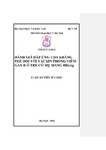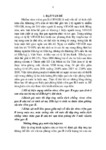
Please use this identifier to cite or link to this item:
http://dulieuso.hmu.edu.vn/handle/hmu/2040| Title: | Đánh giá đáp ứng tạo kháng thể sau tiêm phòng vắcxin viêm gan B ở trẻ có mẹ mang HBsAg |
| Authors: | Phí Đức, Long |
| Advisor: | PGS.TS. Nguyễn vinh, Hà PGS.TS. Nguyễn văn, Bàng |
| Keywords: | 62720135;Nhi khoa |
| Abstract: | Tóm tắt những đóng góp mới của luận án. Với thiết kế nghiên cứu cắt ngang mô tả đánh giá tỷ lệ lây truyền HBV từ mẹ sang con ngay sau khi sinh trên 335 cặp (mẹ mang HBsAg và con) tại các khoa sản của các bệnh viện Phụ sản Hà Nội, bệnh viện E, bệnh viện Bạch Mai, nhà hộ sinh quận Hai Bà Trưng, thành phố Hà Nội, và khoa Phụ sản bệnh viện tỉnh Thái Bình kết hợp với nghiên cứu can thiệp trước sau tự đối chứng tại cộng đồng bằng tiêm phòng vắcxin viêm gan B (VGB) cho 246 trẻ con của các bà mẹ này. Đề tài luận án thu được các kết quả và những đóng góp mới sau:. 1. Xác định được mức độ lây truyền virus viêm gan B từ mẹ sang con ở mẹ HBsAg(+). Tỷ lệ lây truyền dọc VRVGB từ các bà mẹ có HBsAg(+) khi sinh sang con qua xét nghiệm dấu ấn nhiễm virus này trong máu cuống rốn con là: HBsAg: 61,5%, HBeAg: 13,8%. Tỷ lệ lây truyền cao hơn khi mẹ đồng thời có HBsAg(+) và HBeAg(+) với dấu ấn nhiễm virus này trong máu cuống rốn con là: HBsAg: 76,4%, HBeAg: 36,4%. Tỷ lệ lây truyền thấp hơn khi mẹ có HBsAg(+) và HBeAg(-) với dấu ấn nhiễm virus này trong máu cuống rốn con là: HBsAg: 54,2%, HBeAg: 2,7%.. 2. Đánh giá được hiệu quả tiêm phòng vắcxin VGB cho con các bà mẹ HBsAg(+). Tỷ lệ tiêm chủng thành công [HBsAg(-) và định lượng kháng thể ≥10 mIU/ml] là 87,4% (215/246); trong đó 49,6% có đáp ứng miễn dịch yếu (nồng độ kháng thể 10-100 IU/ml), 37,8% có đáp ứng miễn dịch tốt (kháng thể >100 mUI/ml). Tỷ lệ trẻ tiêm chủng thất bại [định lượng kháng thể thấp <10 mIU/ml hoặc HBsAg(+)] là 12,6% (31/246); trong đó 6,9% (17/246) trẻ vẫn có HBsAg(+) và 5,7% (14/246) trẻ đáp có đáp ứng miễn dịch dưới ngưỡng bảo vệ (nồng độ kháng thể <10 mIU/ml).. 3. Xác định được một số yếu tố ảnh hưởng đến kết quả lúc 12 tháng tuổi sau tiêm phòng vắcxin viêm gan B . Mẹ đồng thời có HBsAg(+) và HBeAg(+) trong máu làm tăng nguy cơ con có VRVGB lên 10 lần và tăng nguy cơ tiêm chủng thất bại lên 4,5 lần so với của trẻ mẹ có HBsAg(+) và HBeAg(-) Mẹ có anti-HBe(+) trong máu làm giảm nguy cơ con có VRVGB xuống 9 lần và giảm nguy cơ tiêm chủng thất bại xuống 2 lần so với của trẻ mẹ có anti-HBe(-). Trẻ có HBsAg(+) trong máu cuống rốn làm tăng nguy cơ có VRVGB lên 12,9 lần và tăng nguy cơ tiêm chủng thất bại lên 11,7 lần. Trẻ có HBeAg(+) trong máu cuống rốn làm tăng nguy cơ có VRVGB lên 6,2 lần và tăng nguy cơ tiêm chủng thất bại lên 3,3 lần. Trẻ có anti-HBe(+) trong máu cuống rốn làm giảm nguy cơ có VRVGB xuống 7 lần và giảm nguy cơ tiêm chủng thất bại xuống hơn 2 lần.. . THE NEW MAIN SCIENTIFIC CONTRIBUTIONS OF THE THESIS. Summary of new main scientific contributions of the thesis. The study was carried out in two consecutive studies: 1.The observational cross-sectional study was aimed at describing the rate of HBV mother to child transmission at birth. 2.The intervention study in community used the trial before and after vaccination of hepatitis B vaccine for infants whose mothers were carrying HBsAg in vaccination schedule at 0-1-2-11 month. The effectiveness of vaccination was then assessed. Several site were selected to obtain blood sample of pairs of mother/ child before birth: E Hospital,Bach Mai Hospital, Hanoi maternity Hospital, ThaiBinh maternity Hospital, Hai Ba Trung maternity home. We had new conclusions:. 1. The transmission of hepatitis B virus from mother to child. The rate of vertical HBV transmission from HBsAg(+) mothers to their children, identified by the presence of HBV markers in umbilical cord blood: HBsAg: 61.5%, HBeAg: 13.8%. The rate of vertical HBV transmission from HBsAg(+) mothers to their children was higher when the mothers also had HBsAg(+) and HBeAg(+), identified by the presence of HBV markers in umbilical cord blood: 76.4%, HBeAg: 36.4%. The rate of vertical HBV transmission from HBsAg(+) mothers to their children was lower when the mother also had HBsAg(+) and HBeAg(-), identified by the presence of HBV markers in umbilical cord blood: HBsAg 54.2%, HBeAg: 2.7%.. 2. The effect of hepatitis B vaccination. The rate of success vaccination (HBsAg(-) and antibody levels ≥10 mIU/ml) was 87.4% (215/246), of which 49.6% have a poor immune response (antibody level: 10-100 IU /ml), 37.8% had a good immune response (antibody level >100 mUI /ml). The rate of failure vaccination [anti-HBs level <10 mIU/ml or HBsAg(+)] was 12.6% (31/246), of which 6.9% (17/246) infants had HBsAg(+) and 5.7% (14/246) infants had antibody level <10 mIU / ml.. 3. The factors affecting the effectiveness of hepatitis-B vaccination when the infants were 12 months old. The risk of HBV infection increased 10 times, the risk of failure vaccination increased 4.5 times in mothers having HBsAg(+)/ HBeAg(-) when compared with that of mothers having HBsAg(+)/ HBeAg(-). The risk of HBV infection decreased 9 times, the risk of failure vaccination decreased 2 times in mothers having anti-HBe(+) when compared with mothers having anti-HBe(-) The risk of HBV infection increased 12.9 times, the risk of failure vaccination increased 11.7 times in infants having HBsAg(+) in umblical cord blood when compared with that of infants having HBsAg(-) in umbilical cord blood. The risk of HBV infection increased 6.2 times, the risk of failure vaccination increased 3.3 times in infants having HBeAg(+) in umblical cord blood when compared with that of infants having HBeAg(-) in umbilical cord blood. The risk of HBV infection decreased 7 times, the risk of failure vaccination decreased more than 2 times in infants having anti-HBe(+) in umblical cord blood when compared with that of infants having anti-HBe(-) in umbliacal cord blood.. |
| URI: | http://dulieuso.hmu.edu.vn//handle/hmu/2040 |
| Appears in Collections: | Luận án (nghiên cứu sinh) |
Files in This Item:
| File | Description | Size | Format | |
|---|---|---|---|---|
| 55_Luan an long Nhi.pdf Restricted Access | 1.68 MB | Adobe PDF |  Sign in to read | |
| 55_24 trang Long Nhi.pdf Restricted Access | 472.54 kB | Adobe PDF |  Sign in to read |
Items in DSpace are protected by copyright, with all rights reserved, unless otherwise indicated.